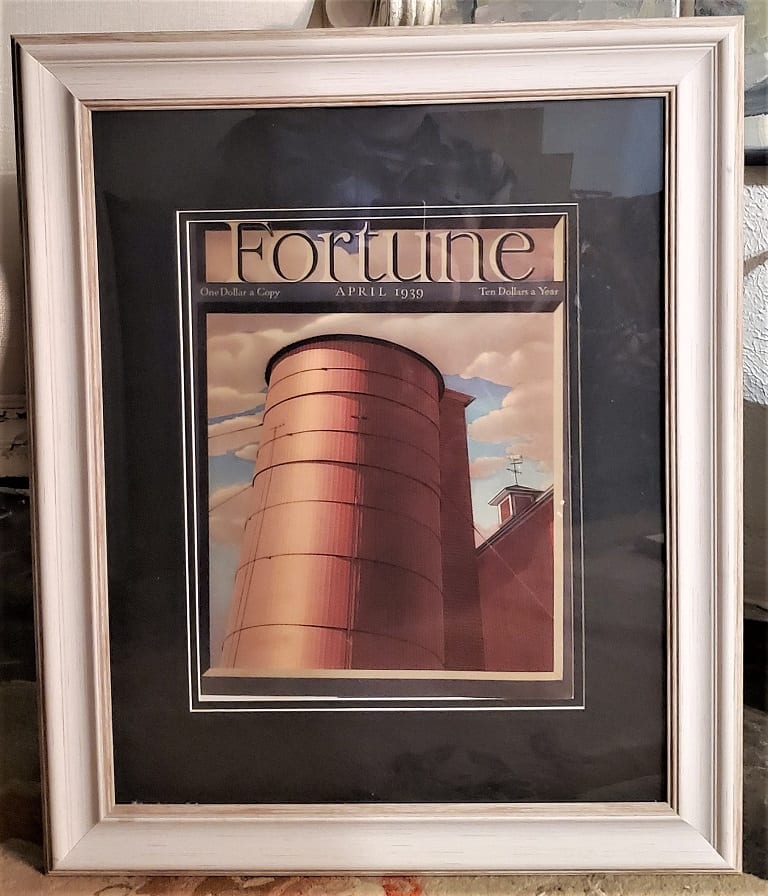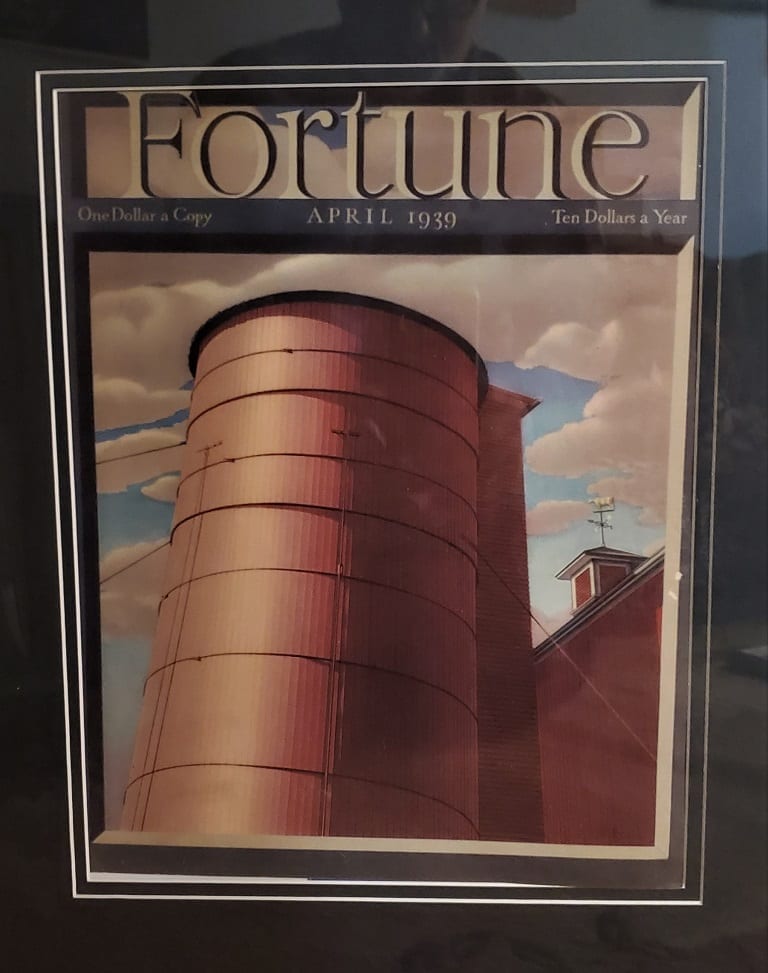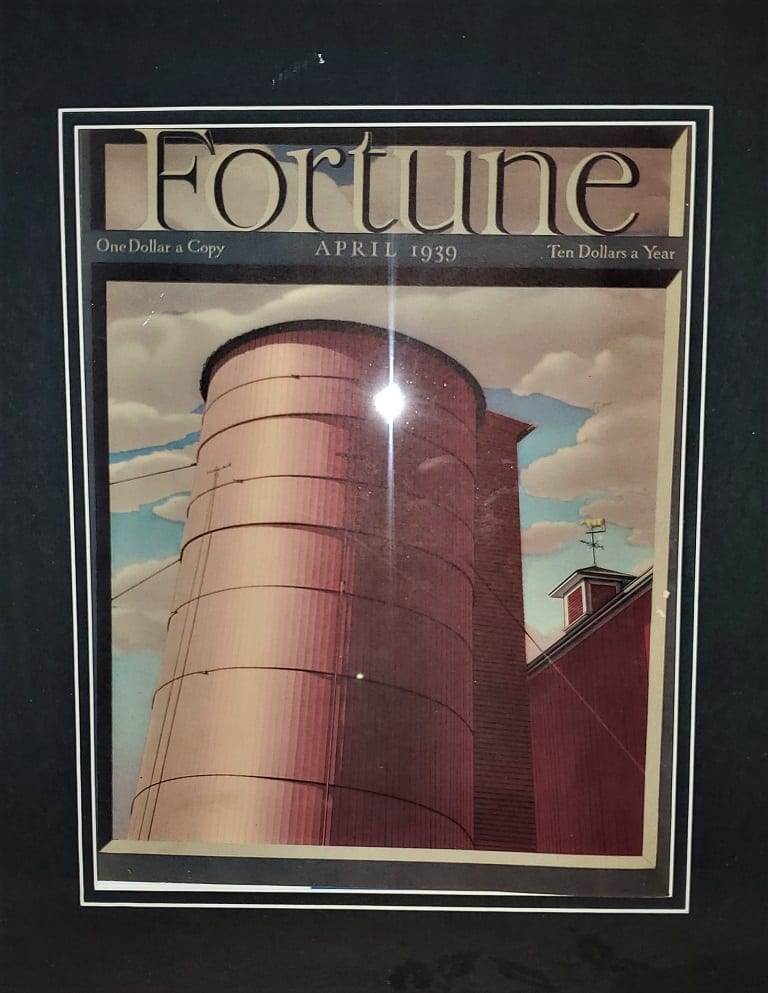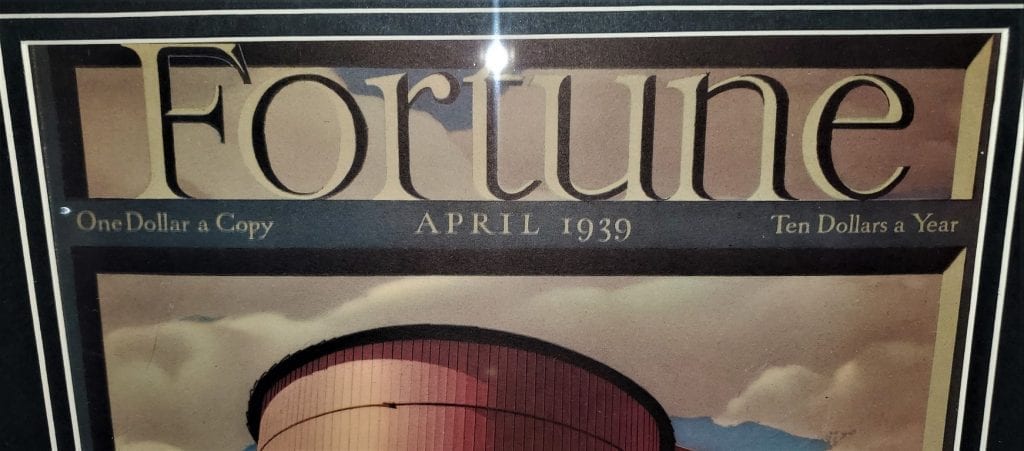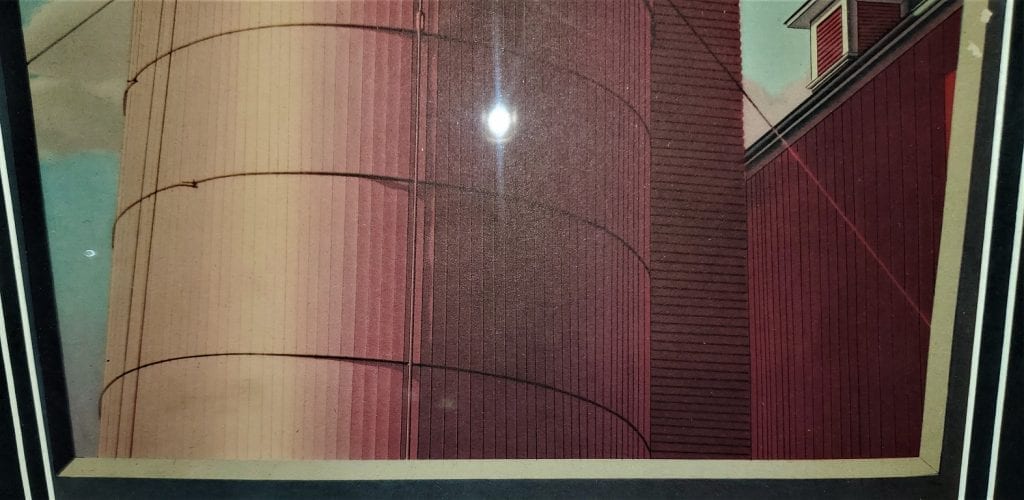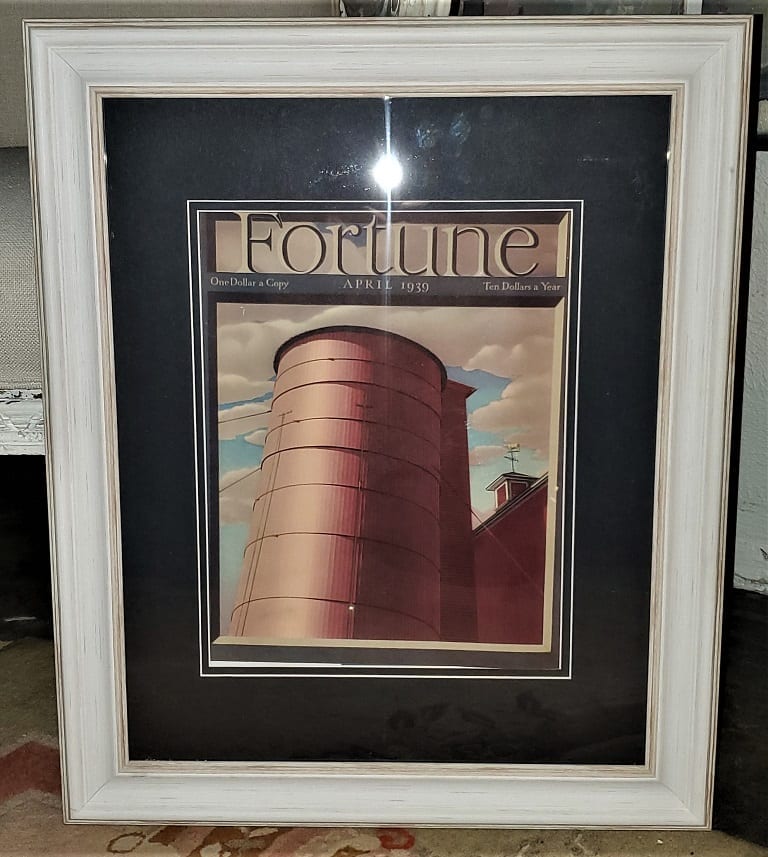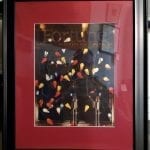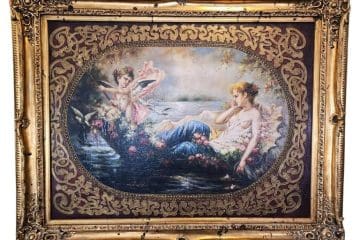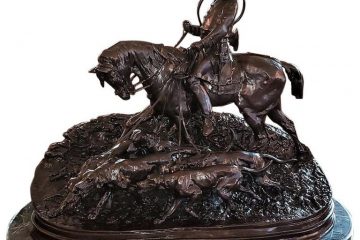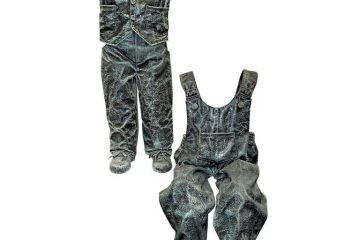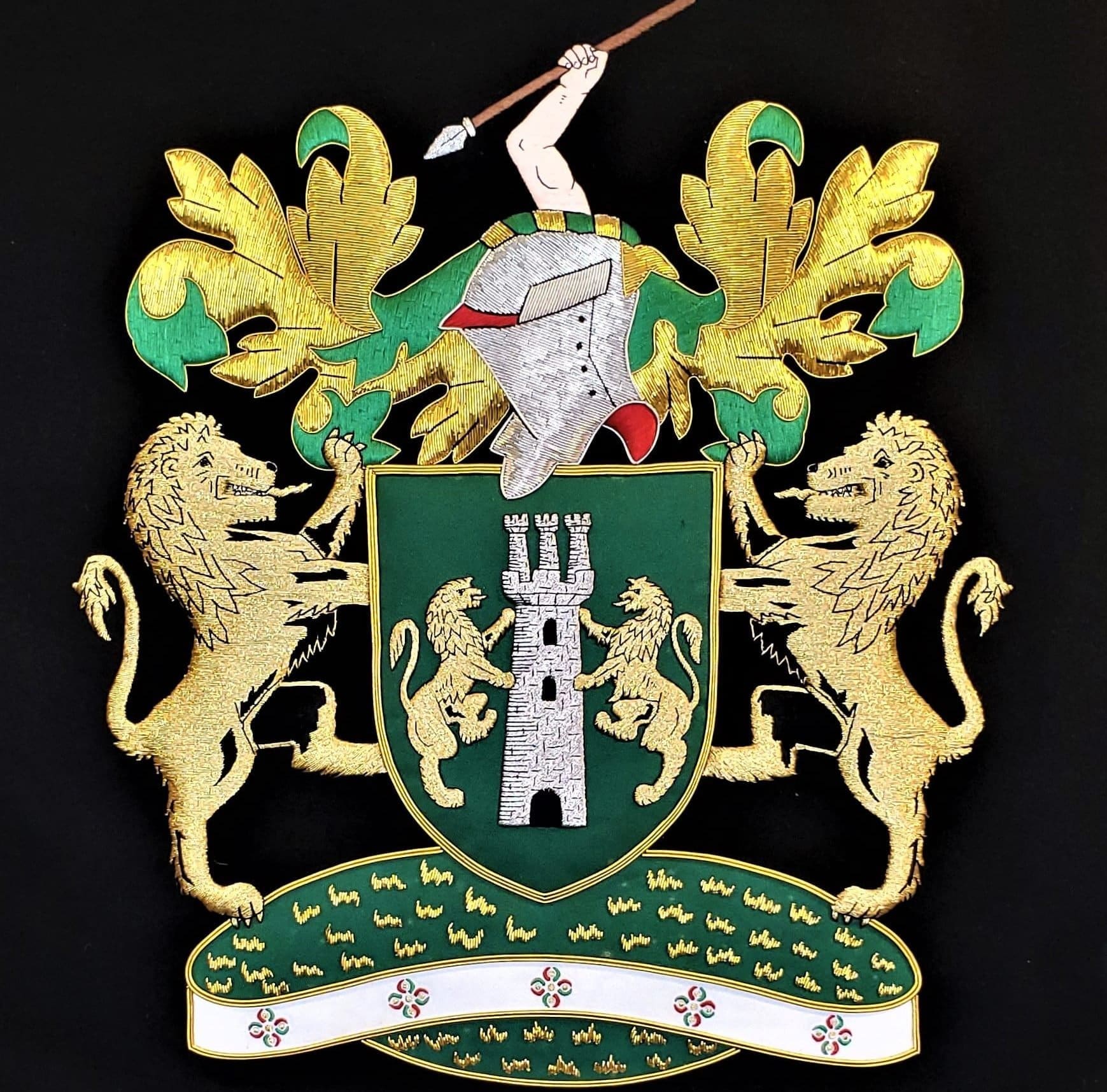Fortune Magazine Cover – April 1939
PRESENTING a FABULOUS Original Fortune Magazine Cover – April 1939.
The cover of Fortune Magazine for April 1939, framed and matted.
This is an ORIGINAL COVER, not a re-print or copy. It is the cover of an actual 1939 Fortune Magazine and we can 100% certify it’s authenticity. We have attached a COA on the back of the frame.
The frame is modern. It is in a distressed faux wood white poster frame with acid free navy beveled matting. Perspex front. The frame and matting are perfect for the style of the era.
The cover print is a depiction of an industrial scene of a grain or corn silo in CLASSIC INDUSTRIAL STYLE.
The cover is in good condition as can be seen from the photos.
This is one of the more iconic covers of Fortune.
Painted by ‘Charles Sheeler’.
Charles Sheeler (July 16, 1883 – May 7, 1965) was an American painter and commercial photographer. He is recognized as one of the founders of American modernism, developing a “quasi-photographic” style of painting known as Precisionism and becoming one of the master photographers of the 20th century.
Charles Rettew Sheeler Jr. was born in Philadelphia, Pennsylvania. He attended the Pennsylvania Museum School of Industrial Art from 1900 to 1903, and then the Pennsylvania Academy of Fine Arts, where he studied under William Merritt Chase. He found early success as a painter and exhibited at the Macbeth Gallery in 1908. Most of his education was in drawing and other applied arts. He went to Italy with other students, where he was intrigued by the Italian painters of the Middle Ages, such as Giotto and Piero della Francesca. Later, he was inspired by works of Cubist artists like Picasso and Braque after a trip to Paris in 1909, when the popularity of the style was skyrocketing. Returning to the United States, he realized that he would not be able to make a living with Modernist painting. Instead, he took up commercial photography, focusing particularly on architectural subjects. He was a self-taught photographer, learning his trade on a five dollar Brownie. Early in his career, he was dramatically impacted by the death of his close friend Morton Livingston Schamberg in the influenza epidemic of 1918. Schamberg’s painting had focused heavily on machinery and technology, a theme which would come to feature prominently in Sheeler’s own work.
Sheeler owned a farmhouse in Doylestown, Pennsylvania, about 39 miles outside Philadelphia, which he shared with Schamberg until the latter’s death. He was so fond of the home’s 19th century stove that he called it his “companion” and made it a subject of his photographs. The farmhouse itself serves a prominent role in many of his photographs, which include shots of the bedroom, kitchen, and stairway. At one point he was quoted as calling it his “cloister.” His work was also part of the painting event in the art competition at the 1932 Summer Olympics.
On April 2, 1939, Sheeler married Musya Metas Sokolova his second wife, six years after the death in 1933 of first wife Katharine Baird Shaffer (married April 7, 1921). In 1942 Sheeler joined the Met museum as a senior research fellow in photography, worked on a project in Connecticut with the photographer Edward Weston, and moved with Musya to Irvington-on-Hudson, some twenty miles north of New York. Sheeler worked for the Metropolitan Museum’s Department of Publications from 1942 to 1945, photographing artworks and historical objects.
Sheeler painted using a technique that complemented his photography and has been described as “quasi-photographic”. He was a self-proclaimed Precisionist, a term that emphasized the linear precision he employed in his depictions. As in his photographic works, his subjects were generally material things such as machinery and structures. He was hired by the Ford Motor Co. to photograph and make paintings of their factories.
Link: https://en.wikipedia.org/wiki/Charles_Sheeler
Fortune was founded by The Atlantic Monthly Company co-founder Henry Luce in 1929 as “the Ideal Super-Class Magazine”, a “distinguished and de luxe” publication “vividly portraying, interpreting and recording the Industrial Civilization”. Briton Hadden, Luce’s business partner, was not enthusiastic about the idea – which Luce originally thought to title Power – but Luce went forward with it after Hadden’s sudden death on February 27, 1929.
In late October 1929, the Wall Street Crash of 1929 occurred, marking the onset of the Great Depression. In a memo to the Time Inc. board in November 1929, Luce wrote: “We will not be over-optimistic. We will recognize that this business slump may last as long as an entire year.” The publication made its official debut in February 1930. Its editor was Luce, managing editor Parker Lloyd-Smith, and art director Thomas Maitland Cleland. Single copies of the first issue cost US$1 ($15.3 in 2019). An urban legend says that Cleland mocked up the cover of the first issue with the $1 price because no one had yet decided how much to charge; the magazine was printed before anyone realized it, and when people saw it for sale, they thought that the magazine must really have worthwhile content. In fact, there were 30,000 subscribers who had already signed up to receive that initial 184-page issue. By 1937, the number of subscribers had grown to 460,000, and the magazine had turned half million dollars in annual profit.
At a time when business publications were little more than numbers and statistics printed in black and white, Fortune was an oversized 11″×14″, using creamy heavy paper, and art on a cover printed by a special process. Fortune was also noted for its photography, featuring the work of Margaret Bourke-White, Ansel Adams, and others. Walker Evans served as its photography editor from 1945 to 1965.
During the Great Depression, the magazine developed a reputation for its social conscience, for Walker Evans and Margaret Bourke-White‘s color photographs, and for a team of writers including James Agee, Archibald MacLeish, John Kenneth Galbraith, and Alfred Kazin, hired specifically for their writing abilities. The magazine became an important leg of Luce’s media empire; after the successful launch of Time in 1923 and Fortune in 1930, Luce went on to launch Life in 1936 and Sports Illustrated in 1954.
From its launch in 1930 to 1978, Fortune was published monthly. In January 1978, it began publishing biweekly. In October 2009, citing declining advertising revenue and circulation, Fortune began publishing every three weeks. As of 2018, Fortune is published 14 times a year.
Link: https://en.wikipedia.org/wiki/Fortune_(magazine)
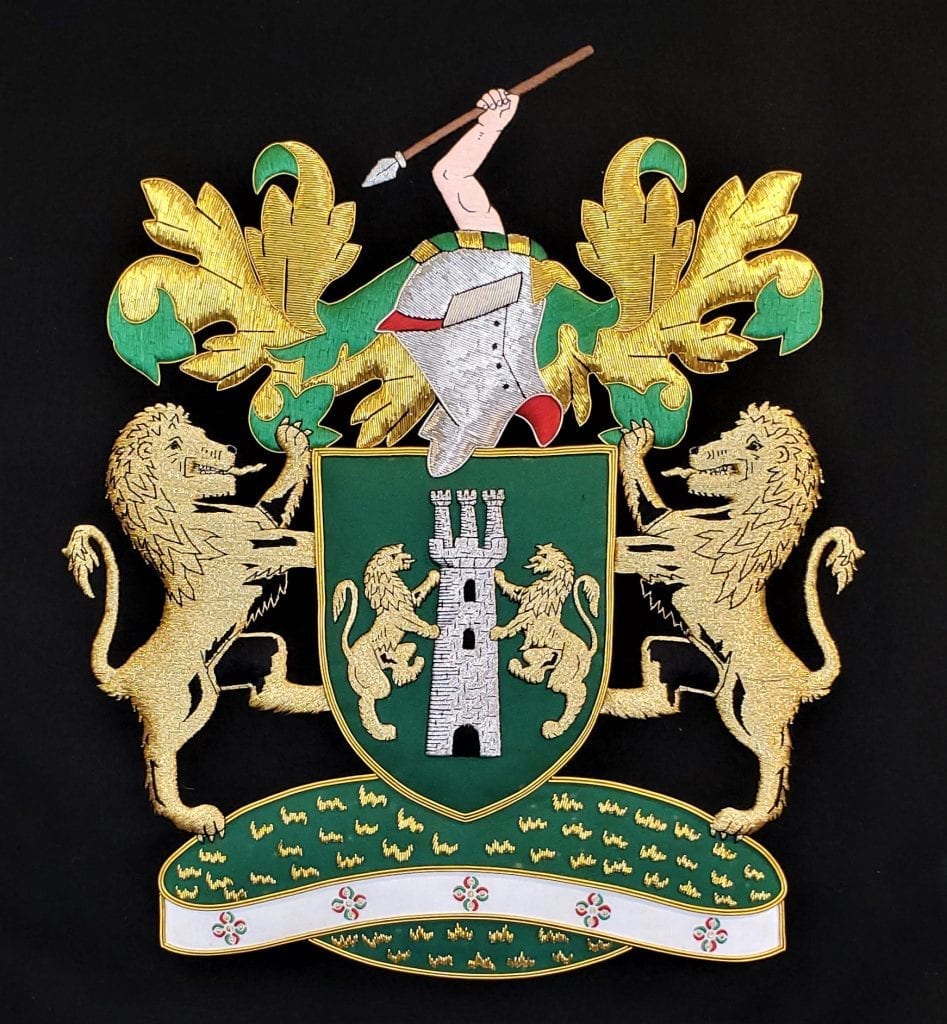

Fortune Magazine Cover – April 1939
Provenance: From a Fine Dallas Estate.
Condition: Very Good.
Dimensions: In Frame: 23.75 inches Tall, 19.75 inches Wide and 0.75 inch Deep
SALE PRICE NOW: $355
